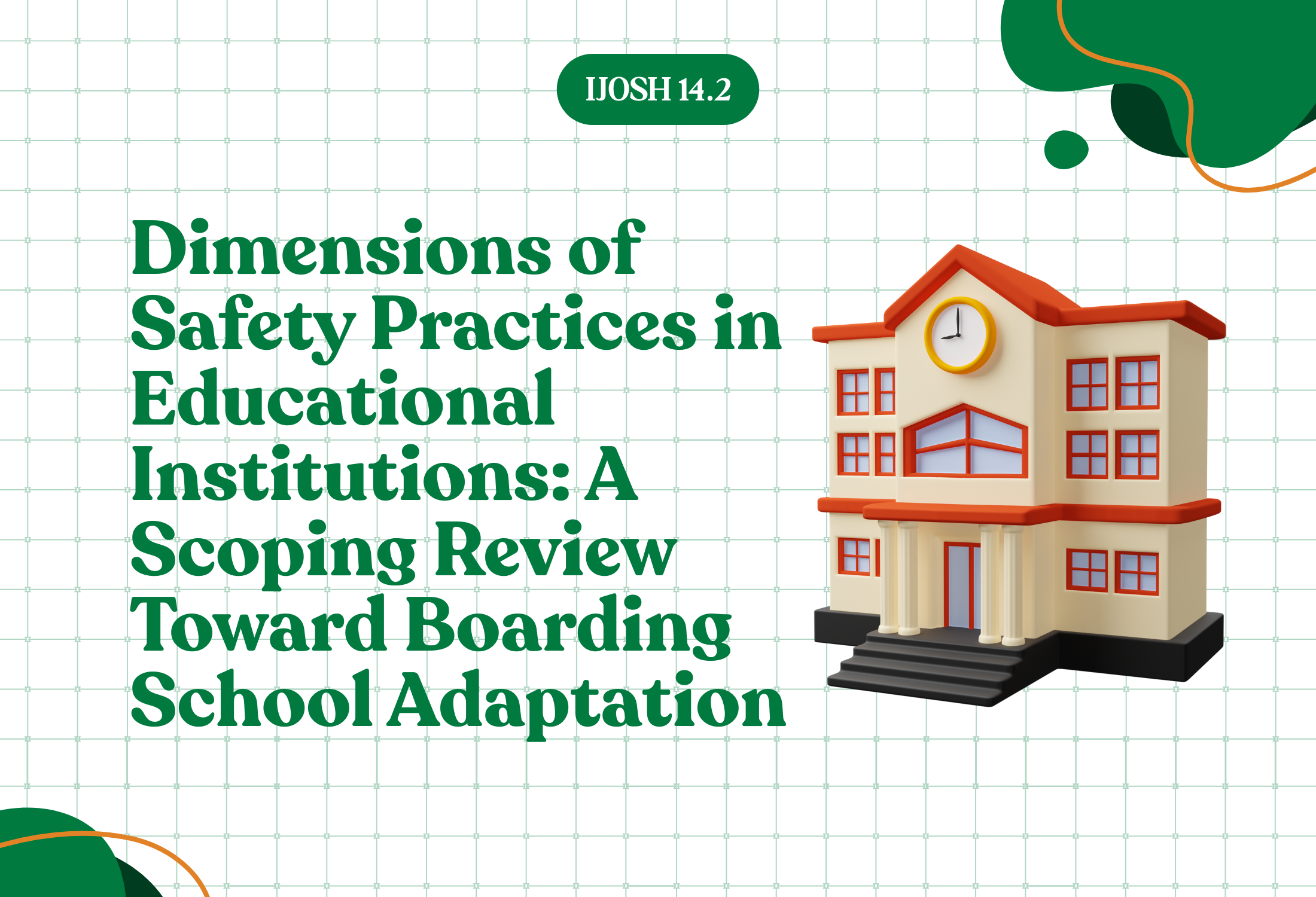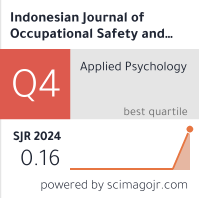Dimensions of Safety Practices in Educational Institutions: A Scoping Review Toward Boarding School Adaptation

Downloads
Introduction: The safety of educational institutions, especially at boarding schools, remains an underexplored area in safety management research. This scoping review aims to identify key dimensions of safety practices in educational institutions to provide a foundational framework for adapting safety assessments to boarding schools. Methods: Through the JBI’s Framework, a comprehensive search of six databases (PubMed, CORE, DOAJ, ScienceDirect, Wiley, and SAGE Journals) yielded 240 articles. After applying inclusion and exclusion criteria, 14 articles were included in the final analysis. Results: Content analysis of these articles revealed four main categories of school safety guidelines: structural and environmental aspects (16 indicators), knowledge aspects (15 indicators), behavioral aspects (13 indicators) and social support aspects (10 indicators). Structural and environmental aspects primarily focused on physical facilities and infrastructure. Knowledge aspects focused on the content of safety education materials that students and teachers must understand. Behavioral aspects focus on daily activities in the educational environment that support a safe culture. Social support focused on the involvement of parties outside the educational institution to support a safety culture. Conclusions: Although none of the reviewed studies focused specifically on boarding schools, the identified dimensions offer a useful starting point for developing a culturally relevant safety assessment tool. This review highlights the lack of context-specific literature and the need for further research, including expert consultation and field validation, to ensure effective safety strategies in boarding school settings.
Amiruddin, A. et al. (2024) ‘Building a Culture of Safety: Teacher and Peer Impact on Safety Behaviors among Vocational High School Students.’, Journal of Education and e-Learning Research, 11(2), pp. 384–393.
Assegaf, S. T., Pramadita, S. and Jati, D. R. (no date) ‘Analysis of Construction Safety Risk Management Based on Indonesia’s Permen PU No. 10/ Year 2021 “Case Study: Provision of Sanitation Facilities In Institutions Religious Education”’, Jurnal Teknik Sipil, 23(1), pp. 125–134.
Cornell, D. et al. (2018) ‘Student threat assessment as a standard school safety practice: Results from a statewide implementation study.’, School Psychology Quarterly, 33(2), p. 213.
Cornell, D. G., Mayer, M. J. and Sulkowski, M. L. (2020) ‘History and future of school safety research’, School psychology review, 50(2–3), pp. 143–157.
Dania, M. et al. (2022) ‘The Production of Safety School Space from Climate Disasters in Doi Mae Salong Forest, Upland Northern Thailand’, Forest and Society, 6(2), pp. 763–788.
Erçek, M. K. and Kiyas Birel, F. (2021) ‘Developing the School Safety Perception Scale: The Validity and Reliability of Study.’, Dinamika Ilmu, 21(1), pp. 37–53.
Hall, W. (2017) ‘The effectiveness of policy interventions for school bullying: A systematic review’, Journal of the Society for Social Work and Research, 8(1), pp. 45–69.
Hidayatulloh, M. A., Rozikan, M. and Musta’anah, A. (2022) ‘School Safety and Security Types in Indonesian Rural and Urban Early Childhood Education Units’, SEA-CECCEP, 3(02), pp. 39–47.
Huda, M. (2024) ‘Strengthening Religious Moderation Through the Core Values of Islamic Boarding School Education’, Al-Hayat: Journal of Islamic Education, 8(1), pp. 59–71.
Jackline, S., Betty J, T. and others (2020) ‘Relationship between implementation of safety standards and guidelines for physical infrastructure, and student safety in public mixed boarding secondary schools in Nakuru County, Kenya’, Editon Consortium Journal of Business and Management Studies.
Kim, H., Carlson, J. S. and Nelson, S. R. (2021) ‘Towards a three-dimensional hardening of schools to promote effective school safety practices in the United States: A systematic review’, Advances in Social Sciences Research Journal, 8(8), pp. 147–162.
Koon, A. D., Hawkins, B. and Mayhew, S. H. (2016) ‘Framing and the health policy process: a scoping review’, Health policy and planning, 31(6), pp. 801–816.
Kurniawan, D., Ismail, M. and others (2020) ‘Building safety index for elementary school building in West Sumatera’, in IOP Conference Series: Materials Science and Engineering, p. 12010.
Madfis, E., Hirschfield, P. and Addington, L. A. (2021) ‘School securitization and its alternatives: The social, political, and contextual drivers of school safety policy and practice’, School psychology review, 50(2–3), pp. 191–205.
Mayer, M. J., Nickerson, A. B. and Jimerson, S. R. (2021) ‘Preventing school violence and promoting school safety: Contemporary scholarship advancing science, practice, and policy’, School psychology review. Taylor & Francis, pp. 131–142.
Mirzaei, S. et al. (2019) ‘School resilience components in disasters and emergencies: a systematic review’, Trauma Monthly, 24(5), pp. 1–13.
Moore, S. A., Ouellette, R. R. and Connors, E. H. (2023) ‘Structural school characteristics and neighborhood risk factors: associations with student-reported school climate in a large, urban public school district in the United States’, in Frontiers in education, p. 931474.
Mori, Y. et al. (2021) ‘Feeling unsafe at school and associated mental health difficulties among children and adolescents: a systematic review’, Children, 8(3), p. 232.
Muazza, M. et al. (2018) ‘Education in Indonesian islamic boarding schools: Voices on curriculum and radicalism, teacher, and facilities’, Islamic Quarterly, 62(4), pp. 507–536.
Mubita, K. (2021) ‘Understanding school safety and security: Conceptualization and definitions’, Journal of Lexicography and Terminology (Online ISSN 2664-0899. Print ISSN 2517-9306)., 5(1), pp. 76–86.
Nahidin, K. et al. (2021) ‘Safe places to learn: Advances in school safety research and practice’, School psychology review, 50(2–3), pp. 91–99.
Nahidin, K. (2023) ‘Cultural Awareness of Bilingual Learners: A Case Study Contextualized in an Islamic Boarding School’, Mastery: Master of English Language Journal, 1(2), pp. 91–99.
Pal, A. et al. (2023) ‘Assessment of vulnerability and resilience of school education to climate-induced hazards: a review’, Development Studies Research, 10(1), p. 2202826.
Pasi, K. M. H., Rasyidin, R. and Harahap, R. M. (2020) ‘Education System of Modern Islamic Boarding School in The Postmodern Era’, Nazhruna: Jurnal Pendidikan Islam, 3(3), pp. 311–323.
Peters, M. D. J. et al. (2020) ‘Updated methodological guidance for the conduct of scoping reviews’, JBI evidence synthesis, 18(10), pp. 2119–2126.
Peterson, J. et al. (2017) ‘Understanding scoping reviews: Definition, purpose, and process’, Journal of the American Association of Nurse Practitioners, 29(1), pp. 12–16.
Pisaniello, D. L. et al. (2013) ‘The role of high schools in introductory occupational safety education--Teacher perspectives on effectiveness’, Safety science, 55, pp. 53–61.
Poursadeqiyan, M. and Arefi, M. F. (2020) ‘Health, safety, and environmental status of Iranian school: A systematic review’, Journal of Education and Health Promotion, 9(1), p. 297.
Saadati, M. et al. (2022) ‘Interventions for safety promotion of pedestrians; A scoping review’, Journal of Transport & Health, 24, p. 101277.
Satudata (2023) Pondok Pesantren dalam Angka Tahun 2023, Kementerian Agama RI. Available at: https://satudata.kemenag.go.id/publikasi/read/pondok-pesantren-dalam-angka-tahun-2023.
Savolainen, T. (2023) ‘A safe learning environment from the perspective of Laurea University of applied sciences safety, security and risk management students and staff’, Heliyon, 9(3).
Schmidt, C. J. et al. (2019) ‘Risk and protective factors related to youth firearm violence: a scoping review and directions for future research’, Journal of behavioral medicine, 42, pp. 706–723.
Seddighi, H. et al. (2022) ‘School-based education programs for preparing children for natural hazards: a systematic review’, Disaster Medicine and Public Health Preparedness, 16(3), pp. 1229–1241.
Suryana, A. T. et al. (2020) ‘Kebijakan Pesantren dalam Pengelolaan Pendidikan di Indonesia’, Jurnal Serambi Ilmu, 21(2), pp. 273–286.
Widowati, E. et al. (2019) ‘The utilization of mhealth for assessing child safety education is a necessity’, in 5th International Conference on Physical Education, Sport, and Health (ACPES 19), pp. 268–272.
Yuan, X. et al. (2022) ‘Teacher support matters: the effect of self-control demands on safety behavior of vocational high school students in China’, International journal of environmental research and public health, 19(12), p. 7220.
Zukdi, I. et al. (2022) ‘The Role of Islamic Boarding Schools In Building The Character of The Nation’, Edukasi Islami: Jurnal Pendidikan Islam, 11(01).

This work is licensed under a Creative Commons Attribution-NonCommercial-ShareAlike 4.0 International License.

In order to be accepted and published by The Indonesian Journal of Occupational Safety and Health, Author(s) who submit an article should complete all the review process. The copyright of received articles assigned to the The Indonesian Journal of Occupational Safety and Health and Department of Safety and Health, Universitas Airlangga as publishers of the journal. The intended copyright includes the rights to publish articles in various forms (including reprints).
The Editorial Team of The Indonesian Journal Of Occupational Safety and Health and Department of Safety and Health strive to ensure that no errors occur in the articles that have been published, both data errors and statements in the article.
Users of this website will be licensed to use materials from this website following the Creative Commons Attribution-NonCommercial-ShareAlike 4.0 International License. No fees charged. Please use the materials accordingly.
------------------------------------------------------------------------------------------------------------------------------------------------------------------------------------------
Attribution ” You must give appropriate credit, provide a link to the license, and indicate if changes were made. You may do so in any reasonable manner, but not in any way that suggests the licensor endorses you or your use.
NonCommercial ” You may not use the material for commercial purposes.
ShareAlike ” If you remix, transform, or build upon the material, you must distribute your contributions under the same license as the original.







 How to Submit Articles in OJS
How to Submit Articles in OJS

























